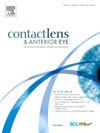Prevalence and clinical characteristics of Keratoconus amongst school children in Mumbai
IF 3.7
3区 医学
Q1 OPHTHALMOLOGY
引用次数: 0
Abstract
Purpose
To determine the prevalence and characterize the clinical profile of keratoconus [KC] among Mumbai schoolchildren.
Methods
A sample of 2 042 students aged 9–17 years was selected from schools in Mumbai through stratified random sampling. Selected participants underwent ocular assessments of visual acuity [VA], auto keratorefractometry [ARK], retinoscopy, ophthalmoscopy, and corneal topography. Descriptive and inferential statistical analyses were conducted utilizing SPSS software version 25.
Results
The prevalence of KC was 3.6% [n = 74], with a mean age of 12.47 ± 1.7 years and 70% being female. Amongst the KC group, 58% were Hindus and 41% Muslims, with consanguinity being significantly associated with KC amongst Muslims (<0.001). In both topography [48.22D vs. 43.58D] and ARK [47.58D vs. 43.16D], K2 [steep keratometry] was higher in the KC as compared to the non-KC group. The I-S index was elevated [2.0D vs. 0.71D], unaided VA worse by 0.35 log units, and myopia [-5.27D vs. -1.89D] and irregular astigmatism [-1.88D vs. -0.68D] more severe in the KC group. Significant asymmetry was noted in the surface asymmetry index, flat and mean K values, myopia, and astigmatic refractive errors [p < 0.001] when comparing better and worse eyes. Retinoscopy showed strong associations with refractive error and topographical findings.
Conclusion
This first population-based study among schoolchildren in Mumbai [aged 9–17] found a significant KC prevalence. A more comprehensive screening approach, incorporating key diagnostic indicators such as topographical indices [mean K, I-S index, an asymmetric bow-tie pattern], positive scissors reflex on retinoscopy, myopia [≥ - 5 D], irregular astigmatism [>1.5 D], VA of 0.35 log units or worse and marked asymmetry between better and worse eyes, proved effective in identifying KC cases. Findings highlight the need to integrate KC detection protocols into school vision programs in Mumbai for early diagnosis and intervention, ultimately improving long-term visual and ocular health outcomes of affected children.
孟买学龄儿童圆锥角膜的患病率及临床特征。
目的:了解孟买学童圆锥角膜的患病率及临床特征。方法:采用分层随机抽样的方法,抽取孟买地区学校9 ~ 17岁学生2042人。选定的参与者接受了视力评估[VA]、自动角膜屈光度测定[ARK]、视网膜镜检查、检眼镜检查和角膜地形图检查。采用SPSS软件25版进行描述性和推断性统计分析。结果:KC患病率为3.6% [n = 74],平均年龄12.47±1.7岁,女性占70%。在KC组中,58%是印度教徒,41%是穆斯林,血缘关系与穆斯林的KC显著相关(结论:首次以人群为基础的孟买学龄儿童研究[9-17岁]发现了显著的KC患病率。采用更全面的筛查方法,结合关键诊断指标,如地形指标[平均K、I-S指数、不对称领结图案]、视网膜镜剪刀反射阳性、近视[≥- 5d]、不规则散光[>1.5 D]、VA为0.35 log单位或更差以及好眼和差眼之间明显不对称,可有效识别KC病例。研究结果强调,有必要将KC检测方案纳入孟买的学校视力项目,以进行早期诊断和干预,最终改善受影响儿童的长期视力和眼部健康结果。
本文章由计算机程序翻译,如有差异,请以英文原文为准。
求助全文
约1分钟内获得全文
求助全文
来源期刊

Contact Lens & Anterior Eye
OPHTHALMOLOGY-
CiteScore
7.60
自引率
18.80%
发文量
198
审稿时长
55 days
期刊介绍:
Contact Lens & Anterior Eye is a research-based journal covering all aspects of contact lens theory and practice, including original articles on invention and innovations, as well as the regular features of: Case Reports; Literary Reviews; Editorials; Instrumentation and Techniques and Dates of Professional Meetings.
 求助内容:
求助内容: 应助结果提醒方式:
应助结果提醒方式:


